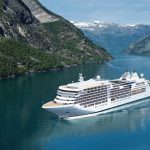
The words were not reassuring: “Swimming with giant tuna,” in a region known as the Great White shark capital of the world.
Welcome to Port Lincoln, Australia, where today on Silver Shadow about 10 of us dared to go where no one else did: out into the sea to swim among tuna that weighed up to 70 pounds and were capable of drawing blood — in a region where there are so many Great White sharks that even the locals think twice before going for a swim.
As we were leaving the ship, a security guard in Port Lincoln told us that only a few days after moving here, he went into the sea to go spear-fishing, startling a couple of local fishermen nearby on shore. “They didn’t expect to see me come back,” he told us. After learning that these waters are infested with Great Whites, he rarely takes a dip into the sea nowadays.

Certainly, we were in for an adventure. Two taxis picked us up pierside and took us about 10 minutes down the road to board a boat operated by Adventure Bay Charters. There, Captain Matt, a young, athletic Aussie whose family has been fishing here for four generations, briefed us about what would be a safe interaction with his favorite fish. “I love to fish tuna, I love to eat tuna and I love to talk about tuna,” he said during the instruction.
Matt told us that it wasn’t too long ago when tuna was selling for only a few cents per kilo. That all changed when Japanese sushi chefs discovered Port Lincoln, and the price shot up dramatically. “We called it living gold,” Matt says. A lot of people became wealthy, and fishing tuna is still one of Port Lincoln’s major sources of income. The largest tuna ever caught here: more than 300 kilos.

The tuna we would see today were for tourism only — not to be eaten. We motored out for about 15 minutes and docked within sight of the shore alongside a circular open pool, with netting to keep out predators, such as seal and shark. There were two options for each of us: We could put on a wet suit and gear up with snorkel and mask to swim with the tuna — and feed them if we wished. Or we could stand on the pier and feed the tuna using tongs. About half of us opted to suit up.
One nice touch is that the pier also features an underwater viewing area, so you can see the massive fish in their natural habitat should you not choose the “full immersion.”

The tuna here feed on sardines, and we had access to a container full for feeding. It was quite safe for those who stood on the pier, using tongs and reaching over a railing while seated.
For those in the water, we could either feed the tuna from our hands, by dangling the sardines from our fingers, or we could simply float around while Matt threw sardines in front of us so that we could get an up-close look at the darting fish that can swim at speeds of up to 70 kilometers per hour.
A few brave souls chose to feed the tuna by hand while in the water, and yes, a few were nipped. Matt had warned us about this, saying that it would feel like a paper cut. Indeed, I did see one wound, not much more than a paper cut, that drew blood. The sensible among us simply floated around the pool and observed the tuna feeding.

Those who stayed above water seemed to have just as much fun feeding the tuna using the tongs. We discovered that the sea gulls also enjoyed taking the sardines from our high-held hands

We learned quite a bit about the tuna industry, and ended our two-hour excursion by sampling some of the best-grade tuna available. “This would run about $500 in a Tokyo restaurant,” Matt told us. Needless to say, we cleaned the plate.

The chance to swim among tunas was one of the most exhilarating and well-operated shore excursions that I’ve done in my many years of travel, and I’d certainly recommend it to anyone. Matt also operates diving excursions with the Great Whites. I’ll save that for another day — and a little more courage.




